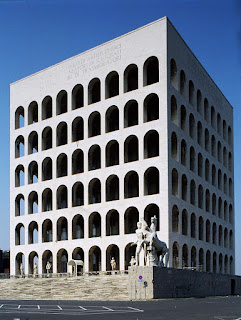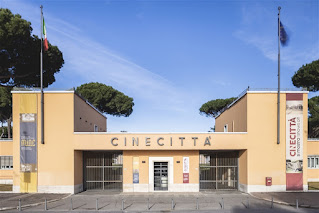Giovanni Michelucci - architect
Designer made mark with railway station and motorway church
The architect Giovanni Michelucci, whose major legacies include the Santa Maria Novella railway station in Florence, died on this day in 1990 in his studio just outside the Tuscan city at Fiesole. Considered by many to be the 'father' of modern Italian architecture, he was only two days away from his 100th birthday. He was still working and is said to have been inspecting progress on his latest project when he slipped and fell, later suffering a cardiac arrest. Michelucci, who was born in Pistoia on January 2, 1891, is also remembered for the brilliantly unconventional church of San Giovanni Battista, with its tent-like curved roof, which forms part of a rest area on the Autostrada del Sole as it passes Florence. The Santa Maria Novella station project for which he first won acclaim came after a collective of young architects known as the Tuscan Group, co-ordinated by Michelucci, beat more than 100 other entries in a national competition in the early 1930s to build a new station behind the church of the same name. The linear design was loathed by conservatives but loved by modernists, although it could not be said to conform to the style identifiable as Fascist architecture in Italy at the time. Read more…
______________________________________
Eleonora Gonzaga, Duchess of Urbino
Image of wise ruler has been preserved in paintings
Eleonora Gonzaga, a noblewoman who was painted four times by Titian, was born on this day in 1493 in Mantua. When she was 15 she married Francesco Maria I della Rovere, Duke of Urbino, the 16-year-old nephew of Pope Julius II and the marriage was celebrated at the Vatican in Rome. Eleonora, along with the dowager duchess, Elisabetta Montefeltro, became largely responsible for the internal government of the duchy because Francesco was a captain in the papal army and often absent from Urbino. She also became an important patron of the arts. Eleonora was the eldest of the seven children of Francesco II Gonzaga, Marquess of Mantua and Isabella d’Este. Although her father was a notorious libertine, her mother was also famous for being a patron of the arts. As a result, Eleonora was well educated in reading, writing, Latin, music and needlework, which had made her cultured and very suitable for marriage with another member of the nobility. But, within six years of their marriage, the fortunes of Eleonora and her husband, Francesco, changed suddenly. The new pope, Leo X, ordered Francesco to lead an army in the pope’s planned invasion of France. Read more…
______________________________________
Sought-after painter who captured elegance of Belle Époque
Giovanni Boldini, whose sumptuous images of the rich and famous made him the most fashionable portrait painter in Paris during the Belle Époque era of the late 19th and early 20th centuries, was born in Ferrara on this day in 1842. His subjects included some famous names, including the opera composer Giuseppe Verdi and the actress Sarah Bernhardt, and he had countless commissions from prominent individuals in Parisian society. Boldini's skill was to capture his subject in soft-focus, elongating their features to accentuate beauty and creating a sense of motion in the figures so that they appeared to be both sophisticated and full of life. He dressed his subjects in sumptuous gowns that would grace any fashion catwalk and society women in particular felt the need to confirm their status by having a Boldini portrait to show off to their friends and demanded that their wealthy husbands arrange a sitting. Boldini came from an artistic background. His father, Antonio, painted religious figures and scenes and had a house in Via Voltapaletto, which links Ferrara’s cathedral with the Basilica of San Francesco. Read more…
______________________________________
Giovanni Pascoli – poet
Painful childhood inspired great verse
Giovanni Placido Agostino Pascoli, who was regarded as the greatest Italian poet writing at the beginning of the 20th century, was born on this day in 1855 in San Mauro di Romagna, then part of the Kingdom of Sardinia. Pascoli’s poems in Latin won prizes and he was regarded by the writer Gabriele D’Annunzio as the finest Latin poet since the Augustan age, which lasted from approximately 43 BC to AD 18 and was thought to be the golden age of Latin literature. Although Pascoli was the fourth of ten children, his family were comfortable financially and his father, Ruggero Pascoli, was administrator of an estate of farmland on which they lived. But when Giovanni Pascoli was just 12 years old, his father, returning from Cesena in a carriage drawn by a black and white mare, was shot and killed by an assassin hiding in a ditch at the side of the road. The mare carried on slowly and brought home the body of her master, Ruggero, but the murderer was never brought to justice. Giovanni Pascoli’s mother died the following year and five other children in the family had also died before he became an adult. Read more…
_______________________________________
Festa di San Silvestro – Feast of Saint Sylvester
Celebrating with a meal of pork and lentils for a prosperous New Year
New Year’s Eve in Italy is known as the Festa di San Silvestro in memory of Pope Sylvester I who died on this day in 335 in Rome. It is not a public holiday in Italy but in normal times it is a festive time everywhere, with firework displays, concerts and parties. One custom still followed in some parts of Italy is throwing your old things out of the window at midnight to symbolise your readiness to accept the New Year. Throughout Italy, bars and restaurants are busy with residents and visitors enjoying drinks and meals before seeing in the New Year in the main square when the bells ring at midnight. Popular menu items include cotechino (Italian sausage), zampone (stuffed pig’s trotter) and lenticchie (lentils). Pork is said to represent the fullness or richness of life, while lentils are supposed to symbolise wealth or money. Many Italians believe the coming year could bring prosperity if these foods are eaten on New Year’s Eve. The President of the Republic delivers an end of year message from the Quirinale in Rome, which is shown on most Italian television channels during the evening. There are live concerts in the open air in many squares throughout Italy, some of which are televised. Read more…
_____________________________________
Book of the Day: The Architecture of Modern Italy: Volume Two - Visions of Utopia, 1900-Present, by Terry Kirk
This groundbreaking and authoritative survey is the first truly comprehensive history of modern Italian architecture and urbanism to appear in any language. Told in lively prose, it recounts more than 250 years of experimentation, creativity, and turmoil that have shaped the landscape of contemporary Italy. Visions of Utopia, 1900- Present tracks the development of Italy's architectural avant-garde through the upheavals of the twentieth century. Beginning with the development of Italian art nouveau - stile liberty - and moving through futurism, fascism, rationalism, and on to the creative experimentation of the present day, it explores the work of such pivotal figures as Raimondo d'Aronco, Antonio Sant'Elia, Adalberto Libera, Giuseppe Terragni, Pier Luigi Nervi, Gio Ponti, Carlo Scarpa, Aldo Rossi and Renzo Piano. The Architecture of Modern Italy is exhaustively illustrated with rare period images, new photography, maps, drawings, and plans. With Colin Rowe's Italian Architecture of the 16th Century, it provides a nearly complete overview of the history of Italian architecture.Terry Kirk is a professor of architectural history at the American University of Rome.
.jpg)
.jpg)


.jpg)


.jpg)

.jpg)







_-_DSC05924.JPG)
.jpg)

.jpg)
.jpg)



_2%20(2).jpg)

.jpg)
.jpg)



.jpg)


.jpg)



